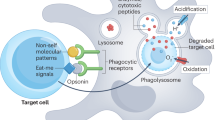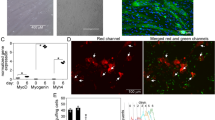Abstract
Examination was made of the involvement of macrophage phagocytosis in programmed cell death of tail and body muscle of the frog, Xenopus laevis, during metamorphosis by electron microscopy and immunohistochemical analysis. Electron microscopic observation revealed that macrophages were often found to be present in body and tail muscles at the most active stage of metamorphosis and to actively phagocytose apoptotic muscle fragments. Developmental changes in macrophages were examined using the macrophage-specific antibody, HAM56. Macrophages initially appeared in the early climax stage (stage 59), when the triiodothyronine (T3) level was high, increased rapidly during the process of muscle cell death, and assumed their greatest number at the late climax stage (stage 63/64). They decreased after stage 65/66, with a decrease in T3. Distribution and change in the number of macrophages were the same as those of muscle apoptotic bodies (sarcolytes) during metamorphosis, which suggests an interactive mechanism between macrophages and dying muscle cells. For clarification of this, study was made of the expression of HAM 56 antigens that were X. laevis homologs of mouse attachmin, non-specific adhesion proteins in macrophages. The expression of HAM56 antigens in macrophages was found to increase with macrophage phagocytosis at the late climax stage, thus, macrophage differentiation would appear to take place during metamorphosis and HAM56 antigens may be essential for macrophage–dying muscle cell interactions.
Similar content being viewed by others
Author information
Authors and Affiliations
Additional information
Accepted: 29 May 1997
Rights and permissions
About this article
Cite this article
Nishikawa, A., Murata, E., Akita, M. et al. Roles of macrophages in programmed cell death and remodeling of tail and body muscle of Xenopus laevis during metamorphosis. Histochemistry 109, 11–17 (1997). https://doi.org/10.1007/s004180050197
Issue Date:
DOI: https://doi.org/10.1007/s004180050197




